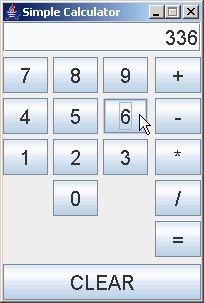1
2
3
4
5
6
7
8
9
10
11
12
13
14
15
16
17
18
19
20
21
22
23
24
25
26
27
28
29
30
31
32
33
34
35
36
37
38
39
40
41
42
43
44
45
46
47
48
49
50
51
52
53
54
55
56
57
58
59
60
61
62
63
64
65
66
67
68
69
70
71
72
73
74
75
76
77
78
79
80
81
82
83
84
85
86
87
88
89
90
91
92
93
94
95
96
97
98
99
100
101
102
103
104
105
106
107
108
109
110
111
112
113
114
115
116
117
118
119
120
121
122
123
124
125
126
127
128
129
130
131
132
133
134
135
136
137
138
139
140
141
142
143
144
145
146
147
148
149
150
151
152
153
154
155
156
157
158
159
160
161
162
|
/** calc-ui-model/CalcGUI.java - A GUI for the calculator.
@author Fred Swartz
@version 2004-04-20 Rodenbach
*/
import java.awt.*;
import java.awt.event.*;
import javax.swing.*;
import javax.swing.event.*;
////////////////////////////////////////////////////////// class CalcGUI
class CalcGUI extends JFrame {
//======================================================= constants
private final Font BIGGER_FONT = new Font("monspaced", Font.PLAIN, 20);
//=============================================== instance variables
//--- Component referenced during execution
private JTextField m_displayField; // display result / input.
//--- Variables representing state of the calculator
private boolean m_startNumber = true; // true: num key next
private String m_previousOp = "="; // previous operation
private CalcLogic m_logic = new CalcLogic(); // The internal calculator.
//====================================================== constructor
public CalcGUI() {
//--- Display field
m_displayField = new JTextField("0", 12);
m_displayField.setHorizontalAlignment(JTextField.RIGHT);
m_displayField.setFont(BIGGER_FONT);
//--- Clear button
JButton clearButton = new JButton("CLEAR");
clearButton.setFont(BIGGER_FONT);
clearButton.addActionListener(new ClearListener());
//--- One listener for all numeric keys.
ActionListener numListener = new NumListener();
//--- Layout numeric keys in a grid. Generate the buttons
// in a loop from the chars in a string.
String buttonOrder = "789456123 0 ";
JPanel buttonPanel = new JPanel();
buttonPanel.setLayout(new GridLayout(5, 3, 5, 5));
for (int i = 0; i < buttonOrder.length(); i++) {
String keyTop = buttonOrder.substring(i, i+1);
if (keyTop.equals(" ")) {
buttonPanel.add(new JLabel(""));
} else {
JButton b = new JButton(keyTop);
b.addActionListener(numListener);
b.setFont(BIGGER_FONT);
buttonPanel.add(b);
}
}
//--- One ActionListener to use for all operator buttons.
ActionListener opListener = new OpListener();
//--- Create panel with gridlayout to hold operator buttons.
// Use array of button names to create buttons in a loop.
JPanel opPanel = new JPanel();
opPanel.setLayout(new GridLayout(5, 1, 5, 5));
String[] opOrder = {"+", "-", "*", "/", "="};
for (int i = 0; i < opOrder.length; i++) {
JButton b = new JButton(opOrder[i]);
b.addActionListener(opListener);
b.setFont(BIGGER_FONT);
opPanel.add(b);
}
//--- Layout the top-level panel.
JPanel content = new JPanel();
content.setLayout(new BorderLayout(5, 5));
content.add(m_displayField, BorderLayout.NORTH );
content.add(buttonPanel , BorderLayout.CENTER);
content.add(opPanel , BorderLayout.EAST );
content.add(clearButton , BorderLayout.SOUTH );
//--- Finish building the window (JFrame)
this.setContentPane(content);
this.pack();
this.setTitle("Simple Calculator");
this.setResizable(false);
}//end constructor
//======================================================== action_clear
/** Called by Clear btn action listener and elsewhere.*/
private void action_clear() {
m_startNumber = true; // Expecting number, not op.
m_displayField.setText("0");
m_previousOp = "=";
m_logic.setTotal("0");
}
/////////////////////////////////////// inner listener class OpListener
/** Listener for all op buttons. */
class OpListener implements ActionListener {
public void actionPerformed(ActionEvent e) {
// The calculator is always in one of two states.
// 1. A number must be entered -- an operator is wrong.
// 2. An operator must be entered.
if (m_startNumber) { // Error: needed number, not operator
action_clear();
m_displayField.setText("ERROR - No operator");
} else {
m_startNumber = true; // Next thing must be a number
try {
// Get value from display field, convert, do prev op
// If this is the first op, m_previousOp will be =.
String displayText = m_displayField.getText();
if (m_previousOp.equals("=")) {
m_logic.setTotal(displayText);
} else if (m_previousOp.equals("+")) {
m_logic.add(displayText);
} else if (m_previousOp.equals("-")) {
m_logic.subtract(displayText);
} else if (m_previousOp.equals("*")) {
m_logic.multiply(displayText);
} else if (m_previousOp.equals("/")) {
m_logic.divide(displayText);
}
m_displayField.setText("" + m_logic.getTotalString());
} catch (NumberFormatException ex) {
action_clear();
m_displayField.setText("Error");
}
//--- set m_previousOp for the next operator.
m_previousOp = e.getActionCommand();
}//endif m_startNumber
}//endmethod
}//end class
//////////////////////////////////// inner listener class ClearListener
/** Action listener for numeric keys */
class NumListener implements ActionListener {
public void actionPerformed(ActionEvent e) {
String digit = e.getActionCommand(); // Get text from button
if (m_startNumber) {
// This is the first digit, clear field and set
m_displayField.setText(digit);
m_startNumber = false;
} else {
// Add this digit to the end of the display field
m_displayField.setText(m_displayField.getText() + digit);
}
}
}
//////////////////////////////////// inner listener class ClearListener
class ClearListener implements ActionListener {
public void actionPerformed(ActionEvent e) {
action_clear();
}
}
}//endclass CalcGUI
|
